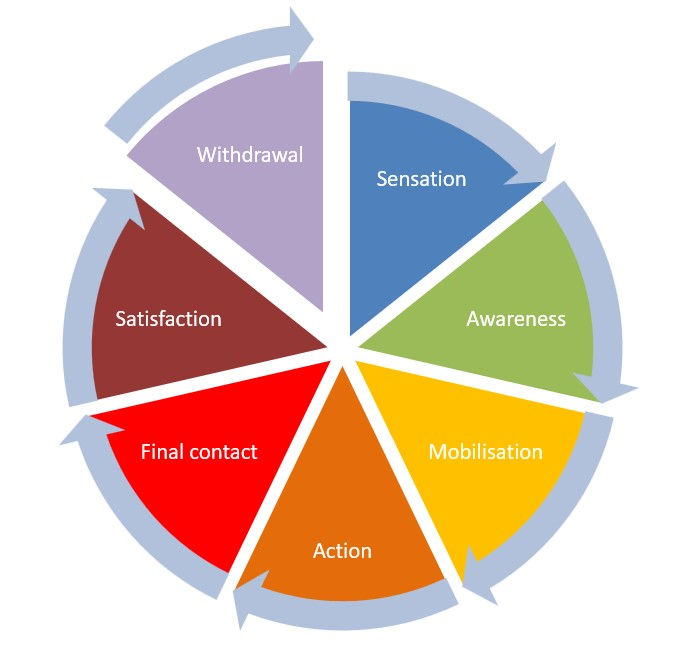Gapness: Restless for a Reason
- alittlesanctuary
- Mar 26
- 4 min read
Updated: Mar 28

In the previous blog, The Gap Between Us: What Makes Therapy a Privilege, I began to explore the idea of gapness—that subtle, insistent feeling that something needs to happen, that something isn’t quite right. It's the quiet ache of incompleteness, the itch of unrest, the pull of longing.
Gapness begins as a felt sense. It might feel like unease, yearning, or even lostness. It doesn’t always announce itself dramatically. Sometimes it’s just a whisper—something’s off.
We're encountering it all the time:
Feeling cold → Reaching for a jumper → Feeling warm and settled
Stomach rumbling → Making a sandwich → Feeling full
Noticing a crooked picture → Straightening it → Visual satisfaction
These examples might seem mundane, but they reveal a deeper process. In each, we respond to the discrepancy between what is and what should be—what I’d call a kind of blueprint. That inner sense of “how things ought to be” nudges us toward action, resolution, wholeness. Sometimes this is as simple as restoring physiological balance—a homeostasis. Other times, it’s more complex.
Psychological and emotional gapnesses follow the same principle:
Feeling creatively blocked → Taking a walk → Inspiration comes
Missing someone → Reaching out → Connection → Heart settles
Burnout → Sabbatical → Rebalancing
Shame → Sharing the story in therapy → Being met with compassion → Integration
And then there are the existential gapnesses:
Outgrowing a career → Retraining → Life pivots
Midlife restlessness → Therapy or pilgrimage → Reorientation
Facing mortality → Acts such as creating a will or saying what needs to be said → Deepened presence
In each case, the here-and-now is experienced as misaligned with a deeper, sometimes barely articulated, ideal. A gap opens up. Life invites us to respond.
I’ve explored this before as a theory of consciousness and as giving rise to the perception of time — gapness as the engine behind our forward motion. But what does this mean in the therapy room?
One useful parallel comes from Gestalt theory, specifically the Gestalt Contact Cycle (Petruska Clarkson, 1989):

It describes a natural rhythm: a sensation gives rise to awareness, awareness gives rise to mobilisation, mobilisation gives rise to action, action gives rise to contact, and contact gives way to satisfaction. Psychotherapy might enter when this cycle stalls—when awareness doesn't lead to mobilisation, or action doesn't result in contact.
Gapness, then, is not just a state of being. It is the start of a process. Seen existentially, our lives unfold in chapters—defined by moments of gapness and their resolution. Each chapter ends with a kind of temporary completeness. But the story continues. A new gap opens. And so we move, again and again.
Therapy, in this view, is decentred. It doesn’t own the process; it supports it. We’ve navigated gapness for millennia—through kinship, community, creativity, and ritual. But therapy offers something potent: a specialised form of social contact, where gapness is not just felt, but articulated. Not just endured, but explored.
Often, clients arrive with a murky, inchoate sense of something missing. As therapists, we offer another perspective—a fresh pair of eyes, another heart, a different kind of gaze. Sometimes this is enough to illuminate the outlines of what was previously shapeless. This overlay of our knowledge and subjectivity helps the client see their own experience more vividly, more fully. It is both a clarification and an invitation—to movement, to change.
The therapist may then be thought of not just as a fellow traveller but as a kind of midwife, present during the birthing of something new. But this metaphor risks being too tidy. Because there is further complexity: not all gapnesses point in the same direction.
Often, people come to therapy not because they don’t know what they want or need, but because because they are struggling with a core conflict:
Wanting to live authentically vs. fear of rejection
Feeling called to parenthood vs. grieving the freedoms it will cost
Wanting to hold your teenager close vs. knowing they need to find their independence
Commitment to the life's work of a marriage vs. the sense in starting anew
In these cases, the task of therapy isn’t just to draw a map—it’s to face a choice.
I’ve written elsewhere about the existential principle of choice, but here’s what I think is at its emotional heart: Every gapness generates a possibility. Every gap is generative—it points to a life beyond itself. The tragedy of getting stuck in the conflict is that life and its generativity grinds to a halt. But choosing one life sometimes means letting another one go.
This is the concept of opportunity cost: the idea that every yes contains a no. Every birth is paired with a loss. This sacrifice can feel sacred, even mournful. But in this way, gapness becomes more than discomfort. It becomes a compass—pointing us toward the life that wants to be lived.
Far from being in a state of perpetual happiness, we are mostly in a state of navigation—orienting ourselves toward the next station, the next moment of alignment between blueprint and reality. These moments of arrival—however brief—can feel transcendent. Maslow called them Peak Experiences. Csikszentmihalyi called it Flow. I think those moments of arrival can be experienced as a lightness of being.
But they don’t last. The next gap opens. And on we go.
A meditative invitation:
Sit for a moment.
Where is there a sense of gapness in your life right now? Perhaps its experienced in your body as a longing, a restlessness, a frustration?
What kind of life does that gapness want to bring into being?
What would completion look like?
What would the experience of arrival feel like—for your body, your heart, your spirit?
And now: What first step might honour that?

Kommentare